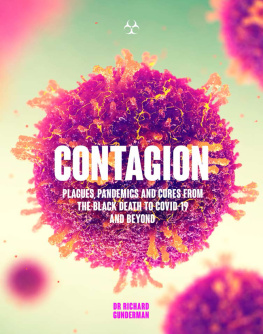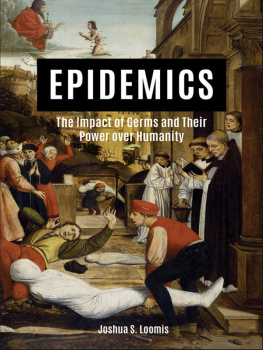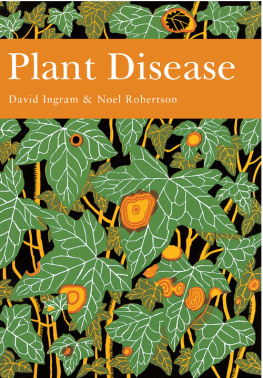KILLER GERMS
MICROBES AND DISEASES THAT THREATEN HUMANITY
REVISED AND UPDATED
Barry E. Zimmerman David J. Zimmerman


Copyright 2003 by Barry E. Zimmerman and David J. Zimmerman. All rights reserved. Printed in the United States of America. Except as permitted under the United States Copyright Act of 1976, no part of this publication may be reproduced or distributed in any form or by any means, or stored in a database or retrieval system, without the prior written permission of the publisher.
ISBN: 978-0-07-170747-3
MHID: 0-07-170747-6
The material in this eBook also appears in the print version of this title: ISBN: 978-0-07-140926-1, MHID: 0-07-140926-2.
All trademarks are trademarks of their respective owners. Rather than put a trademark symbol after every occurrence of a trademarked name, we use names in an editorial fashion only, and to the benefit of the trademark owner, with no intention of infringement of the trademark. Where such designations appear in this book, they have been printed with initial caps.
McGraw-Hill eBooks are available at special quantity discounts to use as premiums and sales promotions, or for use in corporate training programs. To contact a representative please e-mail us at bulksales@mcgraw-hill.com.
TERMS OF USE
This is a copyrighted work and The McGraw-Hill Companies, Inc. (McGraw-Hill) and its licensors reserve all rights in and to the work. Use of this work is subject to these terms. Except as permitted under the Copyright Act of 1976 and the right to store and retrieve one copy of the work, you may not decompile, disassemble, reverse engineer, reproduce, modify, create derivative works based upon, transmit, distribute, disseminate, sell, publish or sublicense the work or any part of it without McGraw-Hills prior consent. You may use the work for your own noncommercial and personal use; any other use of the work is strictly prohibited. Your right to use the work may be terminated if you fail to comply with these terms.
THE WORK IS PROVIDED AS IS. McGRAW-HILL AND ITS LICENSORS MAKE NO GUARANTEES OR WARRANTIES AS TO THE ACCURACY, ADEQUACY OR COMPLETENESS OF OR RESULTS TO BE OBTAINED FROM USING THE WORK, INCLUDING ANY INFORMATION THAT CAN BE ACCESSED THROUGH THE WORK VIA HYPERLINK OR OTHERWISE, AND EXPRESSLY DISCLAIM ANY WARRANTY, EXPRESS OR IMPLIED, INCLUDING BUT NOT LIMITED TO IMPLIED WARRANTIES OF MERCHANTABILITY OR FITNESS FOR A PARTICULAR PURPOSE. McGraw-Hill and its licensors do not warrant or guarantee that the functions contained in the work will meet your requirements or that its operation will be uninterrupted or error free. Neither McGraw-Hill nor its licensors shall be liable to you or anyone else for any inaccuracy, error or omission, regardless of cause, in the work or for any damages resulting therefrom. McGraw-Hill has no responsibility for the content of any information accessed through the work. Under no circumstances shall McGraw-Hill and/or its licensors be liable for any indirect, incidental, special, punitive, consequential or similar damages that result from the use of or inability to use the work, even if any of them has been advised of the possibility of such damages. This limitation of liability shall apply to any claim or cause whatsoever whether such claim or cause arises in contract, tort or otherwise.
To Marilyn and Sondra, our wives and best friends
who are the wind beneath our wings
To Amy, Tara, and Corie, our lovely daughters
for just being there
Thou shalt not be afraid for the terror by night,
nor for the arrow that flieth by day,
nor for the pestilence that walketh in darkness
PSALM 91
Contents
Acknowledgments
MANY THANKS TO Margaret Colvin, Carol Courtney, Ann Halitsky, Bonnie Savitz, Raymond Hernandez of the Lyme Care Center, Dr. Vincent Fischetti, head of the Laboratory of Bacterial Pathogenesis and Immunology at The Rockefeller University, and Dr. David M. Klaus, Associate Director of BioServe Space Technologies, for their guidance and technical assistance.
Introduction
The beginning of health is to know the disease.
CERVANTES
THERE IS EVIDENCE of infectious disease in the fossil of a bird dating back ninety million years. A dental abscess has been found in a human ancestor between one and two million years old. (Human ancestry dates back three to five million years.) Tuberculosis was rather common six thousand years ago, during the New Stone Age, in northern Africa and Europe. Devastating plagues date back several thousand years. A smallpox plague in Rome nearly two thousand years ago killed millions of Roman citizens during a fifteen-year reign of terror. Those who survived the pestilence were often left blind or horribly disfigured. The preserved body of a Chinese noblewoman who died twenty-one hundred years ago showed scars of tuberculosis and three different kinds of worms. The conquest of the New World that began with Columbuss historic voyage was more the result of diseasesmallpox along with measles and influenzathan of swords and bullets. Napolon owed his defeat in Europe to General Typhuswhich, thanks to the bite of a louse, decimated his armiesmore than to any military leader. Typhus also killed three million people during World War I. Bubonic plaguethe Black Deathcaused the collapse of the eastern Roman Empire in the seventh century. It killed twenty-four million Europeans in six years in the middle fourteenth centuryone-third of the European population. According to Frederick Cartwright in Disease and History, Mortality was so great that the Pope consecrated the river Rhne at Avignon, so that corpses flung into the river might be considered to have received Christian burial. The swine flu took the lives of at least twenty million people in six months during the winter of 1918-19. In comparison, World War I killed fifteen million people in four years.
Infectious diseases have always been with us and have shaped human history perhaps more than any other single factor. Yet they are caused by a power unseen. To quote science writer Bernard Dixon, in Power Unseen, A small bacterium weighs as little as 0.000000000001 [one-trillionth] gram. A blue whale weighs about 100,000,000 [one hundred million] grams. Yet a bacterium can kill a whale. The agent of botulism food poisoning is too small to be seen with the naked eye, yet a twelve-ounce glass of the toxin it produces would kill every human beingall 6.2 billionliving on the face of the earth. As small as germs are, they rule the world.
Disease-causing organisms are a diverse group that fit into five separate categories. From simplest to most complex, they are viruses, bacteria, protozoa, fungi, and worms (see ). Unlike the first four, worms are not very small; they are multicellular and, in the case of tapeworms, can be nearly as long as a tennis court.
Table 1 Human Pathogens and Parasites

Of the five categories, those that have posed the greatest threat to developed nations and continue to do so are the viruses and bacteriathe germ diseases. They have been the cause of the worlds great plagues and pandemics. The protozoan and worm diseases are a particular problem in developing nations, especially those with warmer climatesalthough viral and bacterial diseases abound there as well. All disease abounds where there is poverty, overpopulation, and inadequate sanitation and health care.







